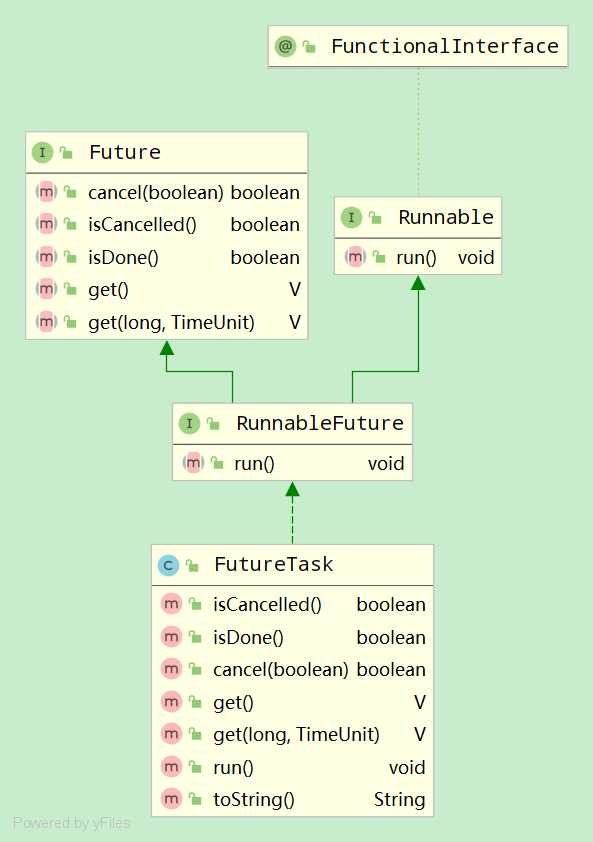标签:event case oss ring weak ansi mil exactly 前置
背景
本文基于JDK 11,主要介绍FutureTask类中的run()、get()和cancel() 方法,没有过多解析相应interface中的注释,但阅读源码时建议先阅读注释,明白方法的主要的功能,再去看源码会更快。
文中若有不正确的地方欢迎大伙留言指出,谢谢了!
FutureTask类图如下(使用IDEA生成)。如图所示,FutureTask实现了Future接口的所有方法,并且实现了Runnable接口,其中,Runnable接口的现实类用于被线程执行,而Future代表的是异步计算的结果。因此,FutureTask类可以理解为,执行run()(实现Runnable接口中的方法),通过Future的get()方法获取结果。

//任务线程总共有七中状态如下: * Possible state transitions: * NEW -> COMPLETING -> NORMAL * NEW -> COMPLETING -> EXCEPTIONAL * NEW -> CANCELLED * NEW -> INTERRUPTING -> INTERRUPTED */ private volatile int state; private static final int NEW = 0; private static final int COMPLETING = 1; private static final int NORMAL = 2; private static final int EXCEPTIONAL = 3; private static final int CANCELLED = 4; private static final int INTERRUPTING = 5; private static final int INTERRUPTED = 6; /** The underlying callable; nulled out after running */ //在run()方法中调用 private Callable<V> callable; /** The result to return or exception to throw from get() */ //任务执行结果,callable.call()正常执行的返回值 private Object outcome; // non-volatile, protected by state reads/writes /** The thread running the callable; CASed during run() */ //任务线程 private volatile Thread runner; /** Treiber stack of waiting threads */ //等待任务结果的线程组成的节点,放在链表对列中 private volatile WaitNode waiters;
public void run() { //1、若是任务的状态不是NEW,且使用CAS将runner置为当前线程则直接返回 if (state != NEW || !RUNNER.compareAndSet(this, null, Thread.currentThread())) return; try { Callable<V> c = callable; //2、任务不为null,且state的状态为NEW的情况下才执行任务 if (c != null && state == NEW) { V result; boolean ran; try { //执行任务并接收执行结果 result = c.call(); //正常执行结果则将标识置为true ran = true; } catch (Throwable ex) { //3、任务发生异常,执行或cancel(),则结果置为null,并记录异常信息 result = null; ran = false; setException(ex); } //4、任务正常结束,则设置返回结果 if (ran) set(result); } } finally { // runner must be non-null until state is settled to // prevent concurrent calls to run() runner = null; // state must be re-read after nulling runner to prevent // leaked interrupts int s = state; //5、若是异常导致,走另一个流程 if (s >= INTERRUPTING) handlePossibleCancellationInterrupt(s); } }
1)若任务的状态不是NEW,或者使用CAS将runner置为当前线程失败,则直接返回的原因是防止多线程调用;
2)再度确认任务执行的前置条件;
3)任务执行异常,将result置为null,并记录异常,setException()源码如下:
protected void setException(Throwable t) { //使用CAS将状态置为中间态COMPLETING if (STATE.compareAndSet(this, NEW, COMPLETING)) { outcome = t; STATE.setRelease(this, EXCEPTIONAL); // final state //任务处于结束态时,遍历唤醒等待result的线程 finishCompletion(); } }
任务的状态变化为NEW - > COMPLETING -> EXCEPTIONAL
4)任务正常结果则会设置result之后,唤醒waitNode的链表对列中等待任务结果的线程;
5)异常后的调用逻辑如下:
//保证调用cancel在run方法返回之前中断执行任务 private void handlePossibleCancellationInterrupt(int s) { // It is possible for our interrupter to stall before getting a // chance to interrupt us. Let‘s spin-wait patiently. if (s == INTERRUPTING) //自旋等待 while (state == INTERRUPTING) //当前线程让出CPU执行权 Thread.yield(); // wait out pending interrupt }
源码分析如下:
public V get() throws InterruptedException, ExecutionException { int s = state; if (s <= COMPLETING) //等待任务完成 s = awaitDone(false, 0L); //返回结果 return report(s); }
其中,等待过程分析如下:
private int awaitDone(boolean timed, long nanos) throws InterruptedException { // The code below is very delicate, to achieve these goals: // - call nanoTime exactly once for each call to park // - if nanos <= 0L, return promptly without allocation or nanoTime // - if nanos == Long.MIN_VALUE, don‘t underflow // - if nanos == Long.MAX_VALUE, and nanoTime is non-monotonic // and we suffer a spurious wakeup, we will do no worse than // to park-spin for a while long startTime = 0L; // Special value 0L means not yet parked WaitNode q = null; boolean queued = false; for (;;) { int s = state; //1、任务的状态已经处于最终的状态,则将任务线程的引用置为null,直接返回状态 if (s > COMPLETING) { if (q != null) q.thread = null; return s; } //2、任务的状态为COMPLETING说明任务已经接近完成,则当前线程让出CPU权限以便任务执行线程获取到CPU执行权 else if (s == COMPLETING) // We may have already promised (via isDone) that we are done // so never return empty-handed or throw InterruptedException Thread.yield(); //3、当前线程被中断,则将当前线程从等待任务结果的对列中移除,并抛出异常 else if (Thread.interrupted()) { removeWaiter(q); throw new InterruptedException(); } //4、任务线程的状态小于COMPLETING,则将当前调用get()方法的线程新建一个Node else if (q == null) { if (timed && nanos <= 0L) return s; q = new WaitNode(); } //5、若由当前线程构成的Node未加入链表中,则加入 else if (!queued) queued = WAITERS.weakCompareAndSet(this, q.next = waiters, q); //6、是否开启了超时获取结果 else if (timed) { final long parkNanos; if (startTime == 0L) { // first time startTime = System.nanoTime(); if (startTime == 0L) startTime = 1L; parkNanos = nanos; } else { long elapsed = System.nanoTime() - startTime; //7、超时则从栈中移除当前线程 if (elapsed >= nanos) { removeWaiter(q); return state; } parkNanos = nanos - elapsed; } // nanoTime may be slow; recheck before parking //当前线程挂起 if (state < COMPLETING) LockSupport.parkNanos(this, parkNanos); } else LockSupport.park(this); } }
获取到返回的状态值后,根据其状态值判断是返回结果还是抛出异常。
public boolean cancel(boolean mayInterruptIfRunning) { //1、若任务线程的状态为NEW,则将其状态从NEW置为INTERRUPTING、CANCELLED if (!(state == NEW && STATE.compareAndSet (this, NEW, mayInterruptIfRunning ? INTERRUPTING : CANCELLED))) //CAS改变任务线程的状态失败,则直接返回false,表示cancel失败 return false; try { // in case call to interrupt throws exception //2、改变任务线程的状态成功后,根据是否中断running的任务线程的标识位,决定是否中断正在运行的任务线程 if (mayInterruptIfRunning) { try { Thread t = runner; //任务线程不为null,则使用interrupt()中断 if (t != null) t.interrupt(); } finally { // final state //设置状态 STATE.setRelease(this, INTERRUPTED); } } } finally { //3、清理等待任务结果的等待线程 finishCompletion(); } return true; }
1)执行run()方法,是在调用在Callable的call()方法,其实在初始化时被指定;
2)调用get()方法,若是任务线程还在执行,则会把调用get的线程封装成waitNode塞入到FutureTask类内部的阻塞链表对列中,可以有多个线程同时调用get()方法;
3)cancel()方法是通过对任务线程调用interrupt()实现;
标签:event case oss ring weak ansi mil exactly 前置
原文地址:https://www.cnblogs.com/love-yh/p/13375236.html